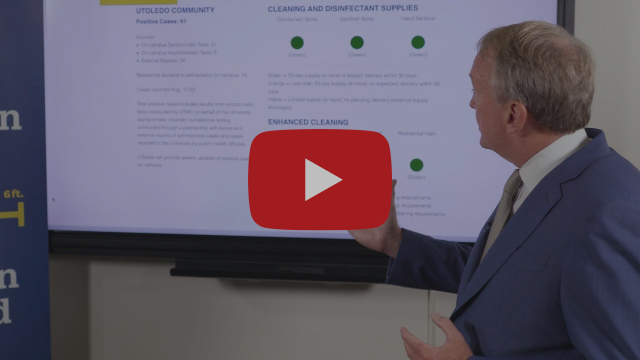Author Archive
UToledo Scientist Developing Single Drug to Treat Diabetes, Osteoporosis
Monday, November 29th, 2021When Dr. Beata Lecka-Czernik joined The University of Toledo College of Medicine and Life Sciences in 2007, her field was seen by many as something of a curiosity.
A professor in the Department of Orthopaedic Surgery with a joint appointment in the Department of Physiology and Pharmacology, Lecka-Czernik studies the connection between bone health and metabolic processes, including disorders such as diabetes.
“At that time, there were very few people believing there even was an intersection,” she said. “It was novel research, but it has really made a lot of progress with time.”
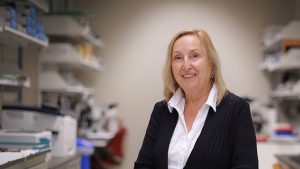
Dr. Beata Lecka-Czernik
Much of that progress has come from her own lab, which has made key discoveries about how some drugs used to treat diabetes can accelerate bone loss, and how a protein called PPAR-gamma that helps regulate insulin sensitivity also plays a role in the formation of new bone.
This fall, Lecka-Czernik received a five-year, $3.4 million grant from the National Institute on Aging to continue her work that’s ultimately aimed at developing a single therapeutic that could both normalize glucose levels and improve the mass and quality of bone.
Osteoporosis and Type 2 diabetes are both widespread in the United States. The National Institutes of Health estimates that 26 million Americans have Type 2 diabetes and twice that many either have or are at high risk of developing osteoporosis.
What’s more, weak bones and diabetes are often seen together. Lecka-Czernik said research has shown that diabetics suffer twice as many bone fractures as individuals without diabetes.
Her research team, which includes scientists from the Scripps Research Institute, will focus on better understanding the mechanisms of how processes in the bone are integrated with regulation of energy metabolism as they work to fine-tune an experimental drug they previously developed.
That compound, which has been patented by Scripps and UToledo, was found to be effective at regulating glucose and strengthening bone in a 2016 study published in the journal EBioMedicine.
Far from serving as a static scaffolding that supports our bodies, bones are constantly changing. One type of cell breaks down old bone and another type of cell creates new bone.
“You can think of it almost like a road crew,” Lecka-Czernik said. “One crew tears up the old pavement and the next crew comes along to lay new blacktop. In normal situations, they are coupled. As we age the destruction crew speeds up but the paving crew slows down, particularly in post-menopausal women.”
Most of the available therapeutics aimed at improving bone quality focus on slowing down resorption, or the process that breaks down old bone.
There is a relatively new drug that helps activate the cells responsible for building new bone by inhibiting the protein sclerostin, but Lecka-Czernik said some scientists have concerns that this drug may have a negative effect on the vascular system.
By targeting PPAR-gamma, which controls the expression of sclerostin, the experimental therapeutic she and her collaborators are investigating potentially gets around that concern.
And unlike some other insulin synthesizers that have been shown to speed up bone loss, the group’s experimental drug appears to do the opposite — building up healthier, stronger bones.
“If you have one pill that can take care of two pathologies which are common and often seen together, that could have a big impact for health. It could also have an economic impact, especially for the elderly who are spending a lot of money on prescription drugs,” she said. “Thirteen years ago, this was science fiction. Now it seems like a real possibility.”
Expectation shapes reality: Psychological factors predict COVID vaccine side effects
Monday, November 8th, 2021Nausea. Chills. Fatigue. Headache.
Before getting vaccinated against COVID-19, many of us braced for the minor but uncomfortable side effects we’d heard so much about in the news or from our friends and neighbors who had already received the jab.
New research led by The University of Toledo suggests how much attention people pay those fears may predict how poorly they’ll feel post-vaccine.
In a paper published last week in the journal Psychotherapy and Psychosomatics, researchers detailed for the first time a link between the side effects people expected from COVID-19 vaccination and those they actually experienced.
“It’s important to see how psychological variables may be correlated to how people respond to these vaccines,” said Dr. Andrew Geers, professor in the UToledo Department of Psychology and the paper’s lead author. “Our research clearly shows that people who expected symptoms like headaches, fatigue or pain at the injection site were much more likely to experience those side effects than those who did not anticipate them.”
Geers’ lab specializes in the study of social psychology theory within health and medical contexts, including the psychology of drug side effects, placebo effects and nocebo effects.
While it’s well documented in the scientific literature how psychosocial factors can impact the success or side effects of a given treatment, no one had yet done so in the context of COVID-19 vaccines.
In April, Geers and his colleagues distributed a survey asking unvaccinated adults in the United States about their expectation for seven common vaccine side effects that had been widely publicized by the U.S. Centers for Disease Control and Prevention — pain at the injection site, fever, chills, headache, join pain, nausea and fatigue. The survey also collected socio-demographic information and assessed participants’ symptoms of depression and general worry about the pandemic.
Over the next three months, researchers followed up with 551 now fully vaccinated participants to ask which of the seven previously identified side effects they experienced.
“We found a clear link between what people expected and what they experienced,” said Kelly Clemens, a UToledo doctoral student studying experimental psychology and paper co-author. “Those psychological factors are predictive over and above the other factors that we knew were involved in predicting side effects, such as the specific vaccine someone received, their age or whether they previously had COVID-19.”
In addition to helping to explain why some of us felt so crummy after vaccination and others did not, Geers and Clemens said the study also could provide important clues for overcoming some of the lingering vaccine hesitancy — both for first timers who are worried about side effects and those who become eligible for a booster dose but don’t want to go through the ordeal again.
“This really shows the power of expectations and beliefs, even in something that we know is very physical,” Geers said. “It appears that the effect that comes out of the vaccine is being shaped by psychology — by expectations and worry. If we’re able to reframe and think about side effects differently, it might reduce the experience of side effects.”
Geers and Clemens are working with colleagues to analyze similar data from other countries to further understand how expectations shape reported vaccine side effects. They also plan to explore additional data that were collected in their survey about other side effects, side effect severity, booster dose intention and social media use.
“This is a really great example of some of the research that our lab does. I think it lays the groundwork for us to move forward not only with COVID vaccines but looking at nocebo side effects more broadly,” Clemens said. “A lot of students don’t get this experience. Dr. Geers is an incredible mentor and he’s been great at helping me be involved at all levels of the research. I’m not just learning good methodology in class, but I’m also able to put it in practice.”
UToledo Develops Experimental Rheumatoid Arthritis Vaccine
Tuesday, October 5th, 2021Researchers at The University of Toledo have developed an experimental vaccine that shows significant promise in preventing rheumatoid arthritis, a painful autoimmune disease that cannot currently be cured.
The findings, detailed in a paper published in the journal Proceedings of the National Academy of Sciences, represent a major breakthrough in the study of rheumatoid arthritis and autoimmune diseases in general.
One of the most common autoimmune diseases, rheumatoid arthritis occurs when the body’s immune system attacks and breaks down healthy tissue — most notably the lining of joints in the hands, wrists, ankles and knees.
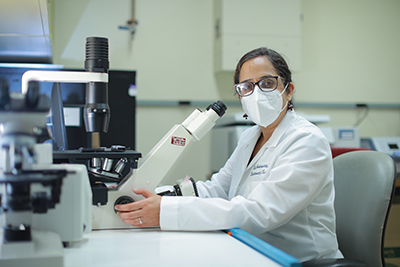
Dr. Ritu Chakravarti
Some estimates suggest rheumatoid arthritis affects as much as 1% of the global population.
“In spite of its high prevalence, there is no cure and we don’t entirely know what brings it on. This is true of nearly all autoimmune diseases, which makes treating or preventing them so difficult,” said Dr. Ritu Chakravarti, an assistant professor in the UToledo College of Medicine and Life Sciences and the paper’s lead author. “If we can successfully get this vaccine into the clinic, it would be revolutionary.”
Chakravarti has for years studied a protein called 14-3-3 zeta and its role in immune pathologies, including aortic aneurysms and interleukin-17— a cytokine associated with autoimmune diseases. Based on their prior work, the research group was focused on the protein as a potential trigger for rheumatoid arthritis.
Instead, they found the opposite.
Rather than preventing rheumatoid arthritis, researchers discovered that removing the protein through gene-editing technology caused severe early onset arthritis in animal models.
Working under a new theory that the 14-3-3 zeta protein protects against rheumatoid arthritis, the team developed a protein-based vaccine using purified 14-3-3 zeta protein grown in a bacterial cell.
They found the vaccine promoted a strong and immediate — but long-lasting — response from the body’s innate immune system, providing protection against the disease.
“Much to our happy surprise, the rheumatoid arthritis totally disappeared in animals that received a vaccine,” Chakravarti said. “Sometimes there is no better way than serendipity. We happened to hit a wrong result, but it turned out to be the best result. Those kinds of scientific discoveries are very important in this field.”
In addition to suppressing the development of arthritis, the vaccine also significantly improved bone quality — a finding that suggests there should be long-term benefits following immunization.
Currently, rheumatoid arthritis is treated primarily with corticosteroids, broad scale immunosuppressive drugs or newer, more targeted biologics that target a specific inflammatory process.
While those therapeutics can alleviate pain and slow the progression of the disease, they also can make patients more vulnerable to infection and, in the case of biologics, can be costly.
“We have not made any really big discoveries toward treating or preventing rheumatoid arthritis in many years,” Chakravarti said. “Our approach is completely different. This is a vaccine-based strategy based on a novel target that we hope can treat or prevent rheumatoid arthritis. The potential here is huge.”
Researchers have filed for a patent on their discovery and are seeking pharmaceutical industry partners to support safety and toxicity studies in hopes of establishing a preclinical trial.
Early Days of HIV Epidemic in Toledo Subject of June 5 Event
Wednesday, June 2nd, 2021The latest segment of the in-process documentary “HIV in the Rust Belt,” which focuses on the lives of local long-term HIV survivors and those who cared for them in the early days of the pandemic, will be presented as part of a virtual event on Saturday, June 5.
Organized by the Ryan White Program at The University of Toledo Medical Center, the event coincides with the 40th anniversary of the virus’s first official virus description by the U.S. Centers for Disease Control and Prevention.
The free, public event begins at 12:30 p.m. via Zoom. Registration is not required.
“HIV in the Rust Belt” is a collaboration of director Holly Hey, professor of film, and co-producer Dr. Ally Day, associate professor of disability studies at UToledo.
“I think most of us would agree we’ve heard some variation of these stories from the coastal perspective, but never anything focused on the Rust Belt and specifically, not on the Toledo region,” Hey said.
Day and Hey have spent the last two years researching and filming for the project, which aims to explain the epidemic through the perspective of those who were on its front lines, either as patients, healthcare providers or leaders of community resource organizations.
The new material being screened on Saturday focuses heavily on Dr. Joan Duggan, a UTMC infectious disease specialist who has long served as medical director of UTMC’s Ryan White Program.
Ahead of the documentary, Duggan will be joined by Dr. Rodger MacArthur, an infectious disease specialist from Augusta University Medical Center in Augusta, Ga., for a discussion about the early days of the HIV response in Toledo. MacArthur, a widely recognized HIV/AIDS expert, worked at the former Medical College of Ohio at the time.
The event is sponsored by the Ann Wayson Locher Memorial Fund for HIV Care held at The University of Toledo Foundation, a fund created for HIV care and research.
The filmmakers expect to spend another year or two shooting before beginning to work on the final cut. They also are exploring other ways to present the material, potentially including a podcast.
“People are connected to the virus and to the time in really unexpected ways, and I find as the director that’s really appealing and one of the most interesting facets of it,” Hey said. “It completely breaks down and explodes stereotypes about who gets it and why they get it.”
The June 5 date is significant for this early showing because it marks 40 years since the virus was officially recognized in the U.S. — and led to changes in how infectious diseases were thought about.
“We thought we had contagious disease covered. When this hits in 1981 and we finally recognize it as a virus we’re terrified because it’s telling us we haven’t actually conquered contagious disease,” Day said. “It was a major wake-up call to the medical community. Forty years later, we’ve made a substantial amount of progress with what we do about HIV, but we still don’t have a vaccine or a cure.”
The HIV in the Rust Belt team also includes co-producers Sue Carter, an HIV social worker with The University of Toledo Medical Center Ryan White Program; Lee Fearnside, development director at Girls on the Run of Northwest Ohio; and Richard Meeker, manager of community engagement and development at the Ryan White Program
The Ryan White Program at UTMC offers high-quality comprehensive care for individuals and families affected by HIV/AIDS. The program offers adult primary care, mental health counseling, case management, advocacy and HIV testing in Lucas County and the surrounding area.
UToledo to Host Virtual Cosmetic Formulation Camp for High School Students
Wednesday, May 26th, 2021The University of Toledo, home to the nation’s only undergraduate program in cosmetic science and formulation design, will host a virtual summer camp for high school students who wish to learn how makeup and personal care products are made.
The two-day camp is scheduled for Wednesday, June 23, and Thursday, June 24. Registration is open until Friday, June 4.
Created and led by Dr. Gabriella Baki, director of the Cosmetic Science and Formulation Design Program and associate professor of pharmaceutics in the College of Pharmacy and Pharmaceutical Sciences, the camp will offer interactive sessions and hands-on activities in which participants will learn the science behind their own health and beauty products.
The camp also will provide an overview of both the industry and UToledo’s unique baccalaureate program.
Established in 2013, the Cosmetic Science and Formulation Design Program teaches students how to design, produce, test and market cosmetics and personal care products.
“Our program is truly a mixture of science, art and business. We really focus on preparing our students for a wide variety of jobs within the industry,” Baki said. “This virtual camp is a great way to introduce high school students to the many opportunities this field provides.”
The camp also will feature presentations and virtual facility tours from several nationally known brands and major industry players, including Bath and Body Works, Estée Lauder, Wacker and Elevation Labs, as well the Society of Cosmetic Chemists.
“Since the camp is virtual, we are recruiting high school students from all states of the U.S,” Baki said. “This allows the college and the cosmetic science program to cast our net wider and spark students’ interest in chemistry, specifically cosmetic chemistry, from a broader region.”
Camp activities will include a virtual scavenger hunt and a panel of alumni of the Cosmetic Science and Formulation Design Program who will share their academic and professional experiences.
Each participant will receive a camp box that will include supplies and samples used in interactive and hands-on sessions and a camp T-shirt.
The camp registration fee is $100 per camper, with financial assistance available.
For more information about and to register for the 2021 Cosmetic Science and Formulation Design Virtual Summer Camp, visit the camp’s website.
UTMC Among First Hospitals Participating in National COVID-19 Drug Study
Tuesday, January 5th, 2021The University of Toledo Medical Center is one of the first sites in the country to enroll patients in a National Institutes of Health study aimed at identifying promising COVID-19 treatments worthy of larger, more in-depth clinical trials.
The proof-of-concept study is intended to quickly screen out ineffective experimental treatments while rapidly advancing deployment of therapeutics that show significant benefit to hospitalized COVID-19 patients.
“This is a very important project,” said Dr. Michael Ellis, an infectious disease specialist and chief medical officer at UTMC. “Right now, we have two primary treatments for COVID-19, the antiviral drug remdesivir and the steroid dexamethasone, but we critically need additional therapeutics. The purpose of this study is to quickly identify agents that could have a big impact in keeping patients off a ventilator, getting them out of the hospital sooner and reducing fatal infections.”
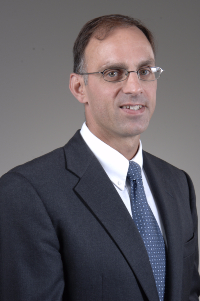
Dr. Michael Ellis
The trial will enroll patients hospitalized with COVID-19 who require oxygen or mechanical ventilation who consent to participate. In the initial portion of the trial, UTMC will be treating patients selected for the clinical trial with either risankizumab or lenzilumab, which are monoclonal antibodies directed at different parts of the inflammatory response that are being investigated as potential treatments for COVID-19.
Both experimental drugs in the study will be paired with remdesivir, which has shown benefit to patients with severe COVID-19 infections.
Monoclonal antibodies are lab-made proteins based on the natural antibodies our immune system produces to fight off disease. Risankizumab was approved in 2019 for the treatment of severe plaque psoriasis. Lenzilumab is in late-stage development as a treatment for leukemia.
“As we treat COVID, our objectives are to stay safe, provide state-of-the-art care and participate in the public health response,” Ellis said. “In this study, we’re participating in a way beyond just Toledo.”
The Phase 2, adaptive, randomized, double-blind placebo-controlled trial will examine both the safety and efficacy of the monoclonal antibodies compared to remdisivir alone.
Up to 40 U.S. sites will be involved in the study. Currently, UTMC is one of nine facilities recruiting participants.
UToledo Infectious Disease, Virology Experts to Discuss COVID-19 at Virtual Town Hall
Tuesday, December 15th, 2020Faculty from The University of Toledo College of Medicine and Life Sciences will participate in a virtual town hall discussion, “UToledo Experts Address COVID-19: Updates and Vaccine Information,” from 5:30 to 6:30 p.m. on Thursday, Dec. 17, via Webex.
The event hosted by the University of Toledo Foundation is free and open to the public, though registration is required.
Presenters include:
• Saurabh Chattopadhyay, assistant professor of medical microbiology and immunology;
• Joan Duggan, infectious disease specialist and professor of medicine;
• Jennifer Hanrahan, infectious disease specialist and associate professor of medicine;
• Jason F. Huntley, associate professor of medical microbiology and immunology; and
• R. Travis Taylor, assistant professor of medical microbiology and immunology.
Dr. Christopher Cooper, dean of the College of Medicine and Life Sciences and executive vice president for clinical affairs, will lead the discussion.
UTMC Offers New Precision Treatment for Prostate Cancer
Tuesday, December 8th, 2020The University of Toledo Medical Center is offering an innovative new outpatient treatment for prostate cancer that uses ultrasound waves to precisely target and destroy cancerous areas while leaving nearby healthy tissue untouched.
Prostate cancer is the second most common form of cancer in men, affecting roughly one out of nine American men during their lifetimes.
Because prostate cancer is often slow-growing, many patients diagnosed with localized cancer take a wait-and-see approach in which the cancer is closely monitored but not immediately treated.
Patients who do elect treatment have traditionally had two options — radiation therapy or surgical removal of the prostate. Those aggressive treatments are effective but often bring serious side effects, including incontinence and sexual dysfunction.
By focusing ultrasound waves on areas as small as a grain of rice, physicians at UTMC can now destroy tumors while minimizing the potential for harming important structures such as nerves responsible for erections, the urinary sphincter, glands responsible for producing semen and non-cancerous prostate tissue.
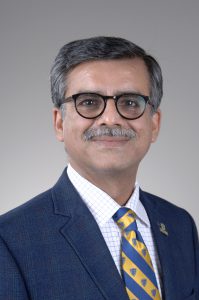
Dr. Puneet Sindhwani
“In very few cancers do we take out the whole organ rather than removing the cancer itself,” said Dr. Puneet Sindhwani, a board-certified urologist at UTMC and chair and Kenneth Kropp Endowed Professor of Urology at The University of Toledo College of Medicine and Life Sciences. “Combining more precise biopsy techniques with high-intensity focused ultrasound provides us an opportunity to treat only the area where we found the cancer and spare the rest of the prostate, reducing the risk of side effects.”
High-intensity focused ultrasound, commonly known as HIFU, has been available in Europe for nearly two decades but is relatively new in the United States.
UTMC is the first and only medical facility in the Toledo region using the state-of-the-art Sonablate device to treat prostate cancer.
“Unlike radical surgery of the prostate where patients may need to be admitted to the hospital, or radiation treatment which requires repeated visits for treatment, another advantage of HIFU is that it can be done in an outpatient setting in one visit,” Sindhwani said. “It is very important in the face of COVID-19 that we minimize patient exposure and also save important care resources for patients who need admission with life-threatening conditions.”
While the technology is approved by the U.S. Food and Drug Administration for destruction of prostate tissue, approval specifically for treating prostate cancer is pending U.S. trials. At this time, Medicare covers only part of the treatment and most private insurance providers don’t cover the treatment expenses. Individuals should check with their insurance provider.
To help make the treatment available in Toledo, the University received a generous grant for urologic innovation from Dr. Ashok Kar, a California-based urologist who completed his surgery and urology training at the former Medical College of Ohio.
UToledo Awarded $1.1 Million Federal Grant to Advance Clean Water Technology
Tuesday, October 6th, 2020Searching for new ways to address the growing threat to drinking water in northwest Ohio and across the globe, Dr. Jason Huntley discovered that native freshwater bacteria can destroy toxins produced during harmful algal blooms.
The University of Toledo scientist has now received a $1.1 million grant from the National Oceanic and Atmospheric Administration to advance that research into real-world solutions.
Huntley, an associate professor in the UToledo Department of Medical Microbiology and Immunology, has already shown in lab experiments that biofilters using those Lake Erie bacteria can remove microcystin at levels exponentially above current exposure guidelines established by the World Health Organization.
“This grant will enable us to extend our research to the next level,” Huntley said. “We did this successfully in the lab. Now we want to scale it up and put the bacteria to work in the water treatment plant.”

Huntley
The three-year research project will take a multifaceted approach to translate Huntley’s earlier finding into technologies that safeguard the drinking water of hundreds of thousands of people.
“One of our big pushes here at UToledo is to not just do science for science’s sake, but to ask questions about how it can improve human health,” Huntley said. “This isn’t just a Toledo problem. There are harmful algal blooms all across the country and all across the world. This is a solution to a global health problem.”
Water treatment plants primarily use activated carbon to capture the microcystin toxins released during some harmful algal blooms. While effective, there are drawbacks. It can be expensive, there’s a limit to how much toxin can be removed from the water and the process generates microcystin-laden waste products that have to be dealt with.
Huntley and his research team believe their bacteria could help address those issues. Biofilters could be used to treat drinking water before it reaches the tap, and the bacteria could be added to the treatment plant byproducts to degrade the lingering toxins.
It’s also an inexpensive solution.
“It’s not free, but it’s really cheap to grow these bacteria that chew up and degrade the toxins. We grow them in water, that’s it. We think we can use them to treat water coming into the treatment plant as well as eliminating toxins in the water treatment byproducts, eliminating the need to incinerate these waste products or send them to a landfill,” Huntley said.
Prior to large-scale testing at the Toledo wastewater treatment plant, researchers will work to further develop and test the biofilters in a range of conditions, such as different water pressures and temperatures.
The research team also will work to isolate and identify the bacterial enzymes that break down microcystin, with a goal of being able to produce them on an industrial scale. Some of that work will be done in collaboration with the Lawrence Livermore National Laboratory — a connection that was made during 2019’s National Lab Day at UToledo. The long-term goal is to develop water treatment tablets or droplet bottles that could be used to quickly detoxify water while boating, at family cabins or while hiking.
Huntley’s early work on this issue was funded by the Ohio Department of Higher Education’s Harmful Algal Bloom Research Initiative and the Ohio Sea Grant. The success of that research helped UToledo earn the NOAA grant.
“This is turning taxpayer money here in Ohio to federally funded grants that bring big money back to Ohio,” Huntley said.
UToledo Launches Dashboard to Report Positive COVID-19 Cases On Campus
Thursday, August 27th, 2020The University of Toledo has launched a public dashboard to provide transparent information about the prevalence of COVID-19 within the UToledo community.
The dashboard, which will be updated weekly, provides information about the number of positive cases among faculty, staff and students across the University. It also includes a snapshot of the University’s current cleaning and disinfectant supplies, as well as enhanced cleaning procedures.
“As the University continues to navigate this pandemic, we want to share what we know about the prevalence of COVID-19 within our campus community,” UToledo Interim President Gregory Postel said. “By building this dashboard, we’re also giving ourselves a better understanding of how cases on campus compare to the community around us, and what data-driven adjustments we may need to make to protect the health of our entire community.”
UToledo’s dashboard is part of a refreshed coronavirus website that details the University’s response to the pandemic.
The positive cases are reported using data from a variety of sources, including tests conducted by The University of Toledo Medical Center on behalf of the University, self-reported cases, and the voluntary surveillance testing of asymptomatic faculty, staff and students.
Recognizing that employees and students may have sought testing through their own healthcare provider, UToledo is closely working with the Toledo-Lucas County Health Department and other public health agencies to receive updated reports of all cases connected to the University.
UToledo has COVID-19 testing available on both Main Campus and Health Science campus through UTMC for all symptomatic employees and students, with test results available in as little as 24 hours. Through a partnership with Azova, the University began voluntary random surveillance testing of asymptomatic faculty, staff and students on Aug. 19.
Additionally, the University is testing all student-athletes upon their return to campus. Surveillance testing of student-athletes will continue throughout the fall semester.
The University is encouraging faculty, staff and students to self-report positive cases in order for the University to more quickly provide appropriate resources and take precautions to keep campus safe.
Should a student require self-isolation due to a positive COVID-19 diagnosis, UToledo has set aside alternative housing to protect the health and safety of all students.


